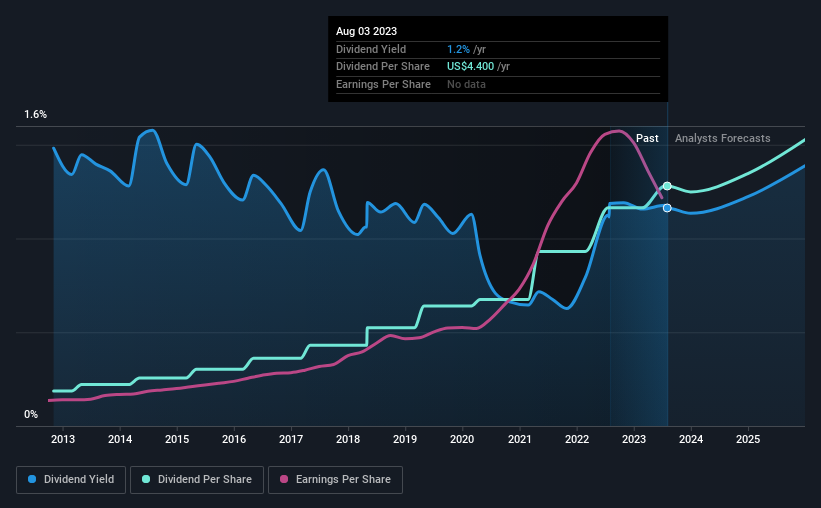Be Sure To Check Out Pool Corporation (NASDAQ:POOL) Before It Goes Ex-Dividend
Pool Corporation (NASDAQ:POOL) is about to trade ex-dividend in the next 4 days. The ex-dividend date is usually set to be one business day before the record date which is the cut-off date on which you must be present on the company's books as a shareholder in order to receive the dividend. It is important to be aware of the ex-dividend date because any trade on the stock needs to have been settled on or before the record date. Accordingly, Pool investors that purchase the stock on or after the 9th of August will not receive the dividend, which will be paid on the 24th of August.
The company's next dividend payment will be US$1.10 per share. Last year, in total, the company distributed US$4.40 to shareholders. Calculating the last year's worth of payments shows that Pool has a trailing yield of 1.2% on the current share price of $378.4. If you buy this business for its dividend, you should have an idea of whether Pool's dividend is reliable and sustainable. So we need to investigate whether Pool can afford its dividend, and if the dividend could grow.
See our latest analysis for Pool
If a company pays out more in dividends than it earned, then the dividend might become unsustainable - hardly an ideal situation. Pool paid out a comfortable 27% of its profit last year. That said, even highly profitable companies sometimes might not generate enough cash to pay the dividend, which is why we should always check if the dividend is covered by cash flow. The good news is it paid out just 21% of its free cash flow in the last year.
It's positive to see that Pool's dividend is covered by both profits and cash flow, since this is generally a sign that the dividend is sustainable, and a lower payout ratio usually suggests a greater margin of safety before the dividend gets cut.
Click here to see the company's payout ratio, plus analyst estimates of its future dividends.
Have Earnings And Dividends Been Growing?
Companies with consistently growing earnings per share generally make the best dividend stocks, as they usually find it easier to grow dividends per share. If earnings fall far enough, the company could be forced to cut its dividend. That's why it's comforting to see Pool's earnings have been skyrocketing, up 26% per annum for the past five years. Earnings per share have been growing very quickly, and the company is paying out a relatively low percentage of its profit and cash flow. Companies with growing earnings and low payout ratios are often the best long-term dividend stocks, as the company can both grow its earnings and increase the percentage of earnings that it pays out, essentially multiplying the dividend.
Another key way to measure a company's dividend prospects is by measuring its historical rate of dividend growth. In the past 10 years, Pool has increased its dividend at approximately 21% a year on average. Both per-share earnings and dividends have both been growing rapidly in recent times, which is great to see.
The Bottom Line
Should investors buy Pool for the upcoming dividend? Pool has been growing earnings at a rapid rate, and has a conservatively low payout ratio, implying that it is reinvesting heavily in its business; a sterling combination. There's a lot to like about Pool, and we would prioritise taking a closer look at it.
While it's tempting to invest in Pool for the dividends alone, you should always be mindful of the risks involved. Every company has risks, and we've spotted 2 warning signs for Pool you should know about.
If you're in the market for strong dividend payers, we recommend checking our selection of top dividend stocks.
Have feedback on this article? Concerned about the content? Get in touch with us directly. Alternatively, email editorial-team (at) simplywallst.com.
This article by Simply Wall St is general in nature. We provide commentary based on historical data and analyst forecasts only using an unbiased methodology and our articles are not intended to be financial advice. It does not constitute a recommendation to buy or sell any stock, and does not take account of your objectives, or your financial situation. We aim to bring you long-term focused analysis driven by fundamental data. Note that our analysis may not factor in the latest price-sensitive company announcements or qualitative material. Simply Wall St has no position in any stocks mentioned.

